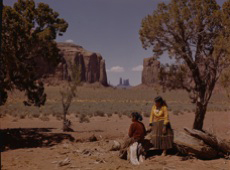History: The Navajo
Between 900 and 1525 A.D. the Navajos developed a rich and complex culture in the area of present-day northwestern New Mexico. Here the Navajos developed trade networks with both the Anasazi and historic Pueblo peoples, bringing new goods and technologies, such as flint points, and moccasins, to the Southwest. The Navajos may have moved into southeastern Utah as early as 1620; by the eighteenth century they had spread into northeastern Arizona and southeastern Utah. The Navajos came into contact with early Spanish explorers in the sixteenth century. In 1680 Navajo and Apache groups aided Pueblo Indians in the Pueblo Revolt, a war for independence from the Spanish, who had brutalized and enslaved the Pueblos for decades. The rebellion forced the Spanish back into Mexico for a time, but in 1693 the Spanish reconquered the area of the Rio Grande Valley. Some Pueblos took refuge among the Navajos, resulting in an intermixing of Navajo and Pueblo cultures. The arrival of the Spanish also introduced sheep, goats, and horses to the Navajo. The Navajo were highly adaptive and incorporated domestic livestock and agriculture into their subsistence system. They also adopted the horse and, like other tribes who used the animal as a means of transportation, sometimes engaged in slave and food raids on neighboring tribes. In the late-eighteenth century, the Navajos became involved in direct conflict with Spanish forces intent on conquering the Southwest. The Spanish formed alliances with the Comanches and Utes to weaken the Navajos, and many fell victim to the Spanish slave trade. The culmination of hostilities came in 1863, when the U.S. Army, under the command of Christopher “Kit” Carson, used “scorched earth” tactics to force the surrender of the Navajo. This defeat resulted in the infamous Long Walk from their homeland to Fort Sumner in central New Mexico. Hundreds died or disappeared during the grueling three-hundred-mile forced march. Those who survived were held at the overcrowded, undersupplied, insanitary Bosque Redondo Reservation at Fort Sumner. After four years of interment, an 1868 treaty allowed the Navajo to return to their original homeland. The Navajo Reservation, set aside by the Treaty of 1868, has subsequently been enlarged through executive order and special legislation, including an 1884 executive order through which much of the land in present-day southeastern Utah was added. The Navajo raised goats and sheep and eventually developed a barter economy, exchanging rugs and silverwork with white traders. In the 1920s, oil and mineral exploration began in the Four Corners region. Oil and gas discoveries in the 1950s and 1960s on the Utah portion of the reservation have enriched the Navajo Nation and the State of Utah a great deal, although oil wells have also caused environmental problems, contaminating water and damaging rangelands. Uranium mining, which began in the 1940s, has also had mixed results for the Navajos. Mining brought much-needed funds to the tribal treasury, but radioactive contamination has left a legacy of death and disease in mining communities. Although Native Americans were not granted citizenship until 1924, Navajos have a proud history of wartime service in the twentieth century. Many Utah Navajos served in the First World War. During World War II, Navajo played a major part in winning the war in the Pacific by developing a code based on the Navajo language that proved impossible for the Japanese to break. These “Code Talkers” are now famous, but over three thousand Navajos also served in the Army, Navy, Marine Corps, and Women’s Army Corps. Several thousand more left the reservation to work in war-related industries. |


 The Navajo tell the story of the Emergence, in which First Man, First Woman, and the people moved from First World to the Fourth World, the Earth-Surface World. First Man brought the four sacred mountains from the Third World to the Earth-Surface World, and these mountains—Sis Naajinii, or White Mountain (Blanca Peak, in Colorado); Tsoodził, or Turquoise Mountain (Mount Taylor, in New Mexico); Dook´o´oosłííd, or Yellow Mountain (Mount Humphreys, in Arizona); and Dibé Ntsaa, or Dark Mountain (Hesperus Peak, in Colorado)—mark the sacred homeland of the Navajo people. Anthropologists hypothesize that the Navajo split off from the Southern Athabaskans and migrated into the Southwest between 200 and 1300 A.D.
The Navajo tell the story of the Emergence, in which First Man, First Woman, and the people moved from First World to the Fourth World, the Earth-Surface World. First Man brought the four sacred mountains from the Third World to the Earth-Surface World, and these mountains—Sis Naajinii, or White Mountain (Blanca Peak, in Colorado); Tsoodził, or Turquoise Mountain (Mount Taylor, in New Mexico); Dook´o´oosłííd, or Yellow Mountain (Mount Humphreys, in Arizona); and Dibé Ntsaa, or Dark Mountain (Hesperus Peak, in Colorado)—mark the sacred homeland of the Navajo people. Anthropologists hypothesize that the Navajo split off from the Southern Athabaskans and migrated into the Southwest between 200 and 1300 A.D.

